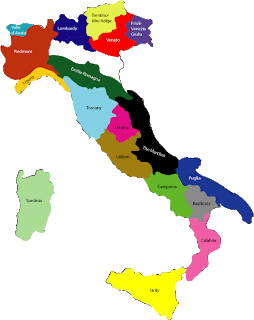In the foggy North, from the Alpine foothills of Piedmont, the tannic red grape Nebbiolo(Spanna) produces the regions famed Barolo DOCG's within its delimited production zone of the Langhe hills. To the east of central Alba, the more feminine Barbaresco's are found from three(3) communes, and in the northern hills the communes of Gattinara and Ghemme produce lighter blended styles from the same grape base. The surrounding provinces produce defining whites from the Moscato and Cortese grapes(Gavi DOCG), as well as aromatic, red Brachetto d'Acqui DOCG, still or frizzante(sparkling), long established as a regional specialty. High acid, low tannin red Barbera and fruity Dolcetto are among the most widely planted varietals in these hills, but usually found in the less prestigious soils.
Head east and Chardonnay in Lombardy's traditional method Franciacorta DOCG is the sparkling superstar, while the remote outpost of Valtellina DOCG, is still a Nebbiolo(Chiavennasca) blend, and a white workhorse, Malvasia is found here as well. A Red Moscato, grown near Bergamo, is the passito base for the speciality Moscato di Scanzo DOCG. Emilia-Romagna, to the south is home to Italy's first white DOCG, Albana di Romagna, made from the local Albana grape, in a volume region mostly known as the producer of volumes of light, red Lambrusco blends.
 | |
| Old & New: Alto Adige trellis & pergolas |
 |
| Montepulciano d'Abruzzo |
In the South, Umbria's popular Orvieto DOC is made from widely cultivated Trebbiano, Grechetto and Malvasia white grapes within the historic commune. The same grapes are blended further South in Latium's Frascati DOC, so popular in the cafe's of Rome. Local native Sagrantino grapes are the base of Umbria's Sagrantino di Montefalco DOCG, which is produced in dry or sweet(dolce) styles, and we also find Sangiovese blended again in the communal DOCG Torgiano Rossa Riserva. Widely planted Trebbiano(Ugli Blanc) appears again in mountainous Abruzzo as Trebbiano d'Abruzzo, but the regions DOCG comes from a local red variety, Montepulciano d'Abruzzo. Towards the Adriatic, the hills of Marche have the high-acid white grape variety Verdicchio, a perfect partner for the local catch of the day, as well as white Vernaccia grapes in numerous DOC blends. Red Montepulciano shows its cloned head again in the regions DOCG, Conero-Rosso Riserva.
Volume-producing Apulia is a dominant red-wine region and home for many migratory ancient varietals, such as the red/black Primitivo and Negromaro grapes. Aglianico is another ancient Greek variety, and known as the Nebbiolo of the South. It is proudly found as the principal red grape in Campania's Taurasi DOCG and in Basilicata's only DOCG, the volcanic-nurtured Aglianico del Vulture. As 'Magna Graecia' other historic white grape varieties, like Greco di Tufo, in still or frizzate styles, and the classic, aromatic Fiano di Avellino found DOCG homes in the Campania sunshine. Fiano was also planted on the large island of Sardinia, but is overshadowed by a more famous white, Vermentino di Gallura DOCG. Across the sea in Liguria the same Vermentino grape is known by the synonym Pigato. While under the Crown of Aragon, the vineyards of Sardinia also rooted imported varieties like the white Tourbat, the red Carignan and Nerello.Not every variety of the South has been imported. Autonomous and mountaneous, Sicily has the native black Nero d'Avola grape, important in producing the islands' Cerasuolo di Vittoria DOCG. Often conquered Sicily is known more as a volume producer and the home of Marsala DOC, a fortified and aged sweet wine from a collection of native white grapes dominated by Catarrato and Grillo.



No comments:
Post a Comment